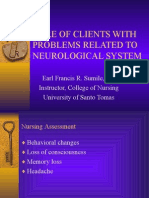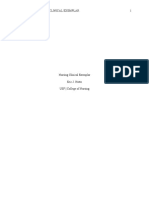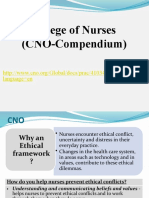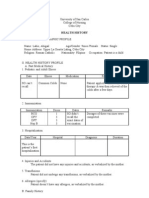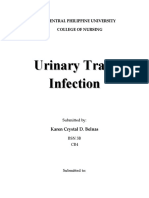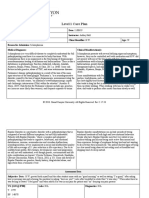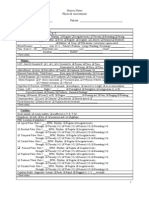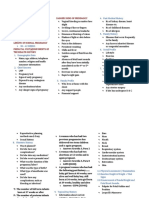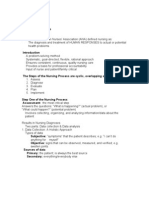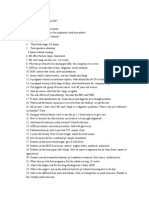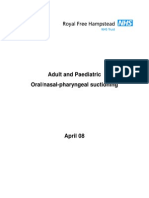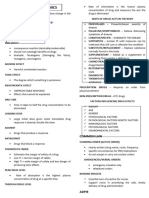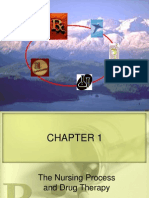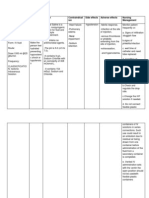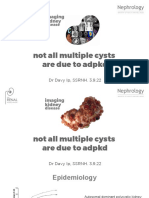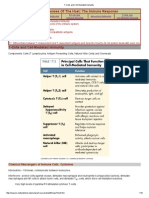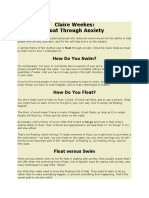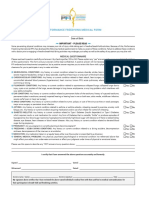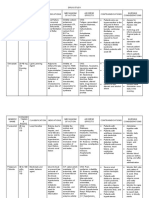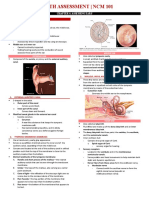Chapter 1: The Nursing Process and Drug Therapy
The Nursing Process
A research-based organizational framework for professional nursing practice
Ensures the delivery of thorough, individualized, and quality nursing care to
patients
Requires critical thinking
Ongoing and constantly evolving process
Five Steps of the Nursing Process
Assessment
Nursing diagnosis
Planning
Goals
Outcome criteria
Implementation including patient education
Evaluation
Assessment
Data collection, review, and analysis
Medication profile
Any and all drug use
Prescriptions
Over-the-counter medications
Vitamins, herbs, and supplements
Compliance and adherence
The nurse answers a patients call light and finds the patient sitting up in bed
and requesting pain medication. What will the nurse do first?
A. Check the orders and give the patient the requested pain medication.
B. Provide comfort measures to the patient.
C. Assess the patients pain and pain level.
D. Evaluate the effectiveness of previous pain medications.
Nursing Diagnosis
Nursing diagnoses are used to communicate and share information about the
patient and the patient experience
Common nursing diagnoses related to drug therapy include:
Deficient knowledge
Risk for injury
Noncompliance
Nursing Diagnosis
Three-step process:
Human response to illness, injury, or significant change
Factors related to the response (related to)
� Listing of cues, clues, evidence, or other data that support the nurses
claim for the diagnosis (as evidenced by)
Planning
Identification of goals and outcome criteria
Goals
Objective, measurable, and realistic with an established time period for
achievement of the outcomes that are specifically stated in the
outcome criteria
Outcome criteria
Concrete descriptions of patient goals
The patients medication administration record lists two antiepileptic
medications that are due at 0900, but the patient is NPO for a barium study. The
nurses coworker suggests giving the medications via IV because the patient is
NPO. What will the nurse do?
A. Give the medications PO with a small sip of water.
B. Give the medications via the IV route because the patient is NPO.
C. Hold the medications until after the test is completed.
D. Call the health care provider to clarify the instructions.
Implementation
Initiation and completion of specific nursing actions as defined by the nursing
diagnoses, goals, and outcome criteria
Independent, collaborative, dependent
The Six Rights of Medication Administration
Right drug
Right dose
Right time
Right route
Right patient
Right documentation
The day shift charge nurse is making rounds. A patient tells the nurse that the
night shift nurse never gave him his medication, which was due at 2100. What
will the nurse do first to determine whether the medication was given?
A. Call the night nurse at home
B. Check the medication administration record
C. Call the pharmacy
D. Review the nurses notes
Evaluation
Ongoing part of the nursing process
Determining the status of the goals and
outcomes of care
Monitoring the patients response to drug therapy
Expected and unexpected responses
Clear concise documentation
A nurse makes an error when administering medications to a patient. Which
action by the nurse requires the supervising nurse to intervene? The nurse
A. completes an incident report.
B. informs the prescriber of the error.
C. documents adverse effects to the medication error.
D. records completion of an incident report in the medical chart.
�Chapter 2: Pharmacologic Principles
Drug: Any chemical that affects the physiologic processes of a living organism
Pharmacology: Study or science of drugs
Drug Names
Chemical name: Describes the drugs chemical composition and molecular
structure
Generic name (nonproprietary name): Name given by the United States
Adopted Names Council
Trade name (proprietary name): The drug has a registered trademark; use of
the name is restricted by the drugs patent owner (usually the manufacturer)
Pharmacologic Principles
Pharmaceutics
Pharmacokinetics
Pharmacodynamics
Pharmacotherapeutics
Pharmacognosy
Pharmacoeconomics
Pharmaceutics: The study of how various drug forms influence the way in which
the drug affects the body
Pharmacokinetics: The study of what the body does to the drug
Absorption
Distribution
Metabolism
Excretion
The nurse is giving a medication that has a high first-pass effect. The health care
provider has changed the route from IV to PO. The nurse expects the oral dose to
be
A. higher because of the first-pass effect.
B. lower because of the first-pass effect.
C. the same as the IV dose.
D. unchanged.
Pharmacodynamics: The study of what the drug does to the body
The mechanism of drug actions in living tissues
Drug-receptor relationships
A patient is complaining of severe pain and has orders for morphine sulfate. The
nurse knows that the route that would give the slowest pain relief would be
which route?
A. IV
B. IM
�C. Subcut
D. PO
Pharmacotherapeutics: The clinical use of drugs to prevent and treat diseases
Defines principles of drug actionsthe cellular processes that change in
response to the presence of drug molecules
Drugs are organized into pharmacologic classes
Pharmacognosy: The study of natural (versus synthetic) drug sources (i.e., plant,
animals, minerals)
Pharmaceutics: Different drug dosage forms have different pharmaceutical
properties.
Dosage form determines the rate of drug dissolution (dissolving of solid
dosage forms and their absorption from the GI tract).
Enteric-coated tablets
Extended-release forms
A patient is prescribed ibuprofen 200 mg PO every 4 hours as needed for pain.
The pharmacy sends up enteric-coated tablets, but the patient refuses the
tablets, stating that she cannot swallow pills. What will the nurse do?
A. Crush the tablets and mix them with applesauce or pudding.
B. Call the pharmacy and ask for the liquid form of the medication.
C. Call the pharmacy and ask for the IV form of the medication.
D. Encourage the patient to try to swallow the tablets.
Pharmacokinetics: A drugs time to onset of action, time to peak effect, and
duration of action
Study of what happens to a drug from the time it is put into the body until the
parent drug and all metabolites have left the body
Absorption: Movement of a drug from its site of administration into the
bloodstream for distribution to the tissues
Bioavailability
First-pass effect
Routes
A drugs route of administration affects the rate and extent of absorption of
that drug
Enteral (GI tract)
Parenteral
Topical
Enteral Route: The drug is absorbed into the systemic circulation through the
oral or gastric mucosa or the small intestine
Oral, Sublingual, Buccal, Rectal (can also be topical)
�Parenteral Route
Intravenous (fastest delivery into the blood circulation), Intramuscular,
Subcutaneous, Intradermal, Intraarterial, Intrathecal, Intraarticular
Topical Route: Skin (including transdermal patches), Eyes, Ears, Nose, Lungs
(inhalation), Rectum, Vagina
The nurse is preparing to administer a transdermal patch to a patient and finds
that the patient already has a medication patch on his right upper chest. What
will the nurse do?
A. Remove the old medication patch and notify the health care provider
B. Apply the new patch without removing the old one
C. Remove the old patch and apply the new patch in the same spot
D. Remove the old patch and apply the new patch to a different, clean area
Distribution: The transport of a drug by the bloodstream to its site of action
Protein-binding
Water-soluble vs. fat-soluble
Blood-brain barrier
Areas of rapid distribution: heart, liver, kidneys, brain
Areas of slow distribution: muscle, skin, fat
Metabolism/Biotransformation: The biochemical alteration of a drug into an
inactive metabolite, a more soluble compound, a more potent active metabolite,
or a less active metabolite
Liver (main organ)
Skeletal muscle
Kidneys
Lungs
Plasma
Intestinal mucosa
Factors that decrease metabolism
Cardiovascular dysfunction, Renal insufficiency, Starvation, Obstructive
jaundice, Slow acetylator, Ketoconazole therapy
Factors that increase metabolism
Fast acetylator, Barbiturate therapy, Rifampin therapy, Phenytoin therapy
Excretion: The elimination of drugs from the body
Kidneys (main organ)
Liver
Bowel: Biliary excretion; Enterohepatic recirculation
�Half-life: The time it takes for one half of the original amount of a drug to be
removed from the body
A measure of the rate at which a drug is removed from the body
Most drugs considered to be effectively removed after about five half-lives
Steady state
The Movement of Drugs Through the Body
Drug actions: The cellular processes involved in the drug and cell interaction
Drug effect: The physiologic reaction of the body to the drug. Includes onset,
peak, and duration of action
Onset, Peak, and Duration
Onset: The time it takes for the drug to elicit a therapeutic response
Peak: The time it takes for a drug to reach its maximum therapeutic response
Duration: The time a drug concentration is sufficient to elicit a therapeutic
response
Therapeutic Drug Monitoring
Peak level: Highest blood level
Trough level: Lowest blood level
Pharmacodynamics: Mechanisms of Action
Receptor interactions
Enzyme interactions
Nonselective interactions
Pharmacotherapeutics: Types of Therapies
Acute therapy
Maintenance therapy
Supplemental/replacement therapy
Palliative therapy
Supportive therapy
Prophylactic therapy
Empiric therapy
Contraindications: Any characteristic of the patient, especially a disease state,
that makes the use of a given medication dangerous for the patient
It is important to assess for contraindications!
Monitoring
Evaluating the clinical response of the patient to the treatment
One must be familiar with the drugs:
Intended therapeutic action (beneficial)
Unintended but potential adverse effects (predictable, adverse drug
reactions)
Therapeutic index
Drug concentration
Patients condition
Tolerance and dependence
Drug interactions (additive effect, synergistic effect, antagonistic effect,
incompatibility)
Adverse drug events
Adverse drug reactions
Pharmacologic reactions, including adverse effects
Hypersensitivity (allergic) reaction
Idiosyncratic reaction
Drug interaction
Other Drug-Related Effects
Teratogenic, Mutagenic, Carcinogenic
Pharmacognosy
Four main sources for drugs: Plants, Animals, Minerals, Laboratory synthesis
Toxicology: The study of poisons and unwanted responses to drugs and other
chemicals. Overlaps with pharmacotherapeutics
�Chapter 3: Lifespan Considerations
Drug Therapy During Pregnancy
Drugs cross the placenta by diffusion
Factors affecting safety:
Drug properties; Fetal gestational age; Maternal factors
FDA has implemented pregnancy safety categories
When teaching a pregnant woman about the use of drugs during pregnancy,
which statement will the nurse include?
A. Exposure of the fetus to drugs is most detrimental during the second
trimester of pregnancy.
B. Pregnant women must never take drugs to control high blood pressure.
C. Drug transfer to the fetus is most likely to occur during the last
trimester of pregnancy.
D. The fetus is at greatest risk for drug-induced developmental defects during
the second trimester of pregnancy.
Drug Therapy During Breastfeeding
Breastfed infants are at risk for exposure to drugs consumed by the mother
Consider risk-to-benefit ratio
Neonatal and Pediatric Considerations: Pharmacokinetics
Absorption
Gastric pH less acidic
Gastric emptying slowed
Intramuscular absorption faster and irregular
Distribution
Greater total body water means lower fat content
Decreased level of protein binding
Immature blood-brain barriermore drugs enter the brain
Metabolism
Liver immature, does not produce enough microsomal enzymes
Older children may have increased metabolism, requiring higher doses than
infants
Other factors
Excretion
Kidney immaturity affects glomerular filtration rate and tubular secretion
Decreased perfusion rate of the kidneys may reduce excretion of drugs
Factors Affecting Pediatric Drug Dosages
Skin is thin and permeable
Stomach lacks acid to kill bacteria
Lungs have weaker mucus barriers
Body temperatures less well regulated, and dehydration occurs easily
� Liver and kidneys are immature, impairing drug metabolism and excretion
Methods of Dosage Calculation for Pediatric Patients
Body surface area method: Uses the West nomogram
Always use weight in kilograms, not pounds
Body weight dosage calculations: Uses mg/kg
When administering medications to pediatric patients, the nurse understands
that the dosage calculations for pediatric patients are different than for adults
because pediatric patients
A. are more likely to develop edema.
B. have more stomach acid.
C. have skin that is less permeable.
D. have immature liver and kidney function, resulting in impaired drug
metabolism and excretion.
Considerations for Elderly Patients
Elderly: older than age 65
High use of medications
Polypharmacy
Noncompliance, nonadherence
Increased incidence of chronic illnesses
Sensory and motor deficits
The Elderly: Pharmacokinetics
Absorption
Gastric pH less acidic
Gastric emptying slowed
Movement through GI tract slowed
Blood flow to GI tract reduced
Use of laxatives may accelerate GI motility
Distribution
Lower total body water percentages
Increased fat content
Decreased production of proteins by the liver, resulting in decreased protein
binding of drugs (and increased circulation of free drugs)
Metabolism
Aging liver produces fewer microsomal enzymes, affecting drug metabolism
Reduced blood flow to the liver
Excretion
Decreased glomerular filtration rate
Decreased number of intact nephrons
The Elderly: Problematic Medications
Analgesics, including NSAIDs and opioids
Anticoagulants
Anticholinergics
Antidepressants
Antihypertensives
Cardiac glycosides (digoxin)
Sedatives and hypnotics, CNS depressants
Thiazide diuretics
Which does the nurse identify as a pharmacokinetic change that occurs in the
elderly?
A. Gastric pH is more acidic
B. Fat content is decreased because of increased lean body mass
C. Increased production of proteins by the liver
D. The number of intact nephrons is decreased
�Chapter 4: Cultural, Legal, and Ethical Considerations
Which racial group is predicted to be nearly one in three U.S. residents in 2050?
A. African American
B. Asian
C. Hispanic
D. White
Cultural Considerations
Influence of ethnicity on genetics and drug response
Drug polymorphism
Compliance level with therapy
Environmental and economic considerations
Barriers to adequate health care for culturally diverse
Cultural Assessment
Languages spoken
Health beliefs and practices
Past uses of medicine
Herbal treatments, folk remedies, home remedies
Over-the-counter drugs and treatment
Usual response to illness
Responsiveness to medical treatment
Religious practices and beliefs
Support from the patients cultural community
Dietary habits
U.S. Drug Legislation
1906: Federal Food and Drugs Act
1912: Sherley Amendment (to the Federal Food and Drug Act of 1906)
1914: Harrison Narcotic Act
1938: Federal Food, Drug, and Cosmetic Act (revision of 1906 act)
1951: Durham-Humphrey Amendment (to the 1938 act)
1962: Kefauver-Harris Amendments (to the 1938 act)
1970: Controlled Substances Act
1983: Orphan Drug Act
1996: Health Insurance Portability and Accountability Act (HIPAA)
2003: Medicare Prescription Drug, Improvement, and Modernization Act
New Drug Development
Investigational new drug (IND) application
Informed consent
U.S. FDA drug approval process
�o
o
o
o
Preclinical testing
Clinical studies
Investigational drug studies
Expedited drug approval
U.S. FDA Drug Approval Process
Preclinical investigational drug studies
Clinical phases of investigational drug studies
o Phase I
o Phase II
o Phase III
o Phase IV
A research group is conducting an investigational drug study on a promising new
drug for osteoporosis. It has been difficult to find research subjects who meet
the criteria. Just before the conclusion of the study, four subjects approach the
researchers and express their desire to withdraw from the study. The researcher
should first
A. inform them that they waited too long to withdraw from the study.
B. explore with them the reasons for withdrawing from the study.
C. acknowledge that they can withdraw at any time from the study.
D. request that they try to remain with the study until it is completed.
Legal Nursing Considerations
State and federal legislation
Nurse practice acts
o Scope of nursing practice
o Expanded nursing roles
o Educational requirements
o Standards of care
o Minimally safe nursing practice
o Differences between nursing and medical practice
Guidelines from professional nursing groups
Institutional policies and procedures, state and federal hospital licensing
Case law or common law
HIPAA
Ethical Considerations
American Nurses Association (ANA) Code of Ethics for Nurses
International Council of Nurses (ICN) Code of Ethics for Nurses
A nurse has been asked to participate in an elective procedure that violates the
nurses personal ethical principles. The nurse should
A. refuse to participate.
�B. ask to switch assignments with another nurse.
C. speak to the manager or supervisor.
D. perform the procedure.
�Chapter 5: Medication Errors: Preventing and Responding
Adverse Drug Event
Medication errors - Institute of Medicine studies (1999, 2006)
Adverse drug reactions: Allergic reaction; Idiosyncratic reaction
In the 2006 Institute of Medicine Study, it was estimated that some form of
medication error resulted in harm to how many patients?
A. 400,000
B. 800,000
C. 1 million
D. 1.5 million
Medication Errors
Preventable
Common cause of adverse health care outcomes
More potential for harm with high-alert medications
Issues Contributing to Errors
Errors can occur during any step of medication process:
o Procuring; Prescribing; Transcribing; Dispensing; Administering;
Monitoring
Organizational issues
Educational system issues
Sociologic factors
Types of Medication Errors
No error, although circumstances or events occurred that could have led to
an error
Medication error that causes no harm
Medication error that causes harm
Medication error that results in death
Preventing Medication Errors
Multiple systems of checks and balances
Legible and correct orders
Appropriate consultation
Check medication order three times
Six Rights of medication administration
Minimize verbal or telephone orders
o Repeat order to prescriber
o Spell drug name aloud
o Speak slowly and clearly
List indication next to each order
Avoid medical shorthand, including abbreviations and acronyms
Never assume anything about items not specified in a drug order (e.g., route)
Do not hesitate to question a medication order for any reason when in doubt
Do not try to decipher illegibly written orders; contact prescriber for
clarification
NEVER use a trailing zero with medication orders (Do not use 1.0 mg; use 1
mg)
ALWAYS use a leading zero for decimal dosages (Do not use .25 mg; use
0.25 mg)
Take time to learn special administration techniques of certain dosage forms
Always verify new medication administration records
Always listen to and honor any concerns expressed by patients regarding
medications
Check patient allergies and identification
The nurse is administering a drug that has been ordered as follows: Give 10
mg on odd-numbered days and 5 mg on even-numbered days. When the date
changes from May 31 to June 1, what should the nurse do?
A. Give 10 mg because June 1 is an odd-numbered day
B. Hold the dose until the next odd-numbered day
C. Change the order to read Give 10 mg on even-numbered days and 5 mg on
odd-numbered days
D. Consult the prescriber to verify that the dose should alternate each day, no
matter whether the day is odd- or even-numbered
Reporting Medication Errors
Report to prescriber and nursing management
Document error per policy and procedure
Factual documentation only
o Medication administered
o Actual dose
o Observed changes in patient condition
o Prescriber notified/follow-up orders
External reporting of errors
o USP MERP (United States Pharmacopeia Medication Errors Reporting
Program)
o MedWatch, sponsored by the FDA
o Institute for Safe Medication Practices (ISMP)
o The Joint Commission
The nursing student realizes that she has given a patient a double dose of an
antihypertensive medication. The tablet was supposed to be cut in half, but the
student forgot and administered the entire tablet. The patients blood pressure
just before the dose was 146/98 mm Hg. What should the student nurse do first?
A. Notify the patients physician
B. Notify the clinical faculty
�C. Take the patients blood pressure
D. Continue to monitor the patient
Medication Reconciliation: Continuous assessment and updating of patient
medication information
Verification; Clarification; Reconciliation
Should be done at each stage of health care delivery:
o Admission
o Status change
o Patient transfer within or between facilities/provider teams
o Discharge
Ethical Issues
Notification of patients
Possible consequences for nurses
�Chapter 6: Patient Education and Drug Therapy
The Domains of Learning
Cognitive domain
Affective domain
Psychomotor domain
Patient Education: Assessment
Adaptation to any illness Age
Cognitive abilities
Coping mechanisms
Developmental status
Education, including
literacy level
Information patient
Folk medicine, home
understands about past
remedies,
and present medical
alternative/complementar
conditions
y therapies
Financial status
Health literacy
Health beliefs
Level of knowledge about
current medications
Nutritional status
Misinformation about
drug therapy
Race and/or ethnicity
Self-care ability
Barriers to learning
Cultural background
Emotional status
Past and present
experience with drug
regimens and other
therapies
Psychosocial growth and
development
Environment
Language(s) spoken
Current medications,
Limitations (physical,
including over-the-counter
psychologic, cognitive,
and herbal medications
motor)
Mobility
Motivation
Past and present health
Family relationships
behaviors
Readiness to learn
Religious beliefs
Sensory status
Social support
The nurse is caring for an 85-year-old patient in the hospital and teaching him
how to use an inhaler. His 84-year-old wife attends the teaching sessions, and
their daughter comes in to visit in the evenings. The patient is having trouble
remembering the steps. The nurse should
A. provide the package insert that comes with the medication for the patient to
read.
B. focus the teaching sessions on the patients wife.
C. provide small amounts of information at a time, repeating information
frequently.
D. wait until the daughter comes in and teach the daughter instead.
Patient Education: Nursing Diagnoses
Deficient knowledge
Impaired memory
Ineffective self-health management
Readiness for enhanced self-health management
Noncompliance
Risk for falls
Risk for injury
Sleep deprivation
A patient with newly diagnosed type 1 diabetes mellitus has completed a
diabetes education program. One month later, the patient confesses at a followup appointment that he just didnt feel like giving himself the insulin
injections. Which nursing diagnosis will the nurse assign the patient?
A. Deficient knowledge
B. Noncompliance
C. Impaired memory
D. Sleep deprivation
Patient Education: Planning
Goals and Outcome Criteria
Measurable
Realistic
Based on patient needs
Stated in patient terms
Time frame
Patient Education: Implementation
Teaching-learning sessions
Consideration of age-related changes
Consideration of language barriers
Safe administration of medications at home
Return demonstration with equipment
For adults, it is recommended that materials be written at an 8th grade level
A nurse is providing patient teaching for a community health center that serves
a primarily Portuguese population. The nurse would best serve this patient
population by
A. learning Portuguese.
B. always using interpreter services.
C. using the family member interpreter the patient provides.
D. finding a job in a different setting.
Patient Education: Evaluation
Validate whether learning has occurred
Ask questions
Have the patient provide a return demonstration
Behavior, such as compliance and adherence to a schedule
Occurrence of few or no complications
Develop and implement new plan of teaching as needed for:
Noncompliance
Inadequate levels of learning
After providing education regarding medications to a patient who has been
newly diagnosed with type 2 diabetes mellitus, the nurse would use which
part of the nursing process to assess whether the patient understands these
new instructions?
A. Assessment
B. Diagnosis
C. Implementation
D. Evaluation

